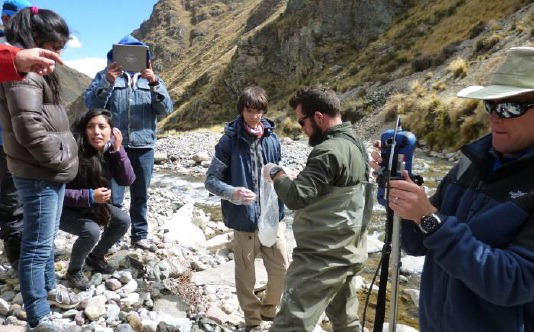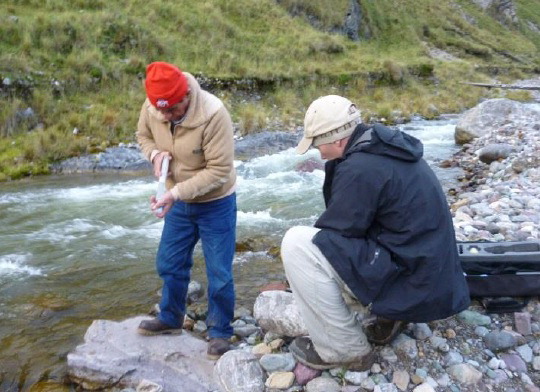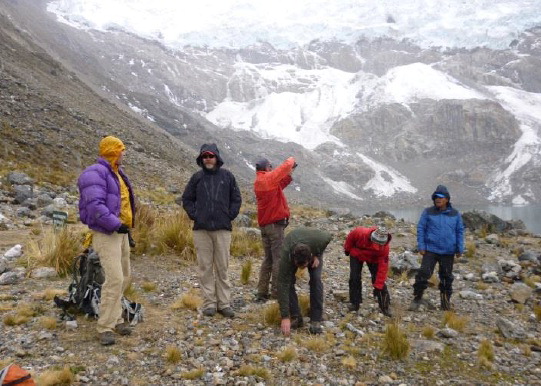U.S. Partner: Bryan G. Mark, The Ohio State University
Project Dates: December 2014 to January 2017
Glaciers in the Peruvian Andes are shrinking faster than expected, and several of them have already disappeared. NSF-sponsored research on glacier studies in the Cordillera Blanca, the most glacierized region of Peru and the global tropics, shows that glacier recession reduces water supply and has far-reaching consequences for the mountain environment and communities. Additionally, the results have shown that during the dry season, hydrologic processes in the pro-glacial zone are often equal in importance as glacier melt water. These high-impact findings were enabled by the development of new Andes-specific methods to measure glacier volume changes, pro-glacier hydrology, and the development of a predictive hydrological model to estimate future river discharge. The results are very compelling and underscore the urgent need to better understand the climate-glacier-society interactions and effectively link them with human activity, policy and local community needs on a broader scale.
The research team in collaboration with the U.S. partner will transfer and apply this new knowledge and methodology in another Peruvian watershed, the Shullcas River watershed, which is also impacted by rapid glacier recession, growing population, and the existing social conflict due to water scarcity, wherein farmers seeking to maintain food security clash with an urban population demanding adequate water availability. The anticipated outcomes of the project include a better understanding of the glacier and groundwater sources of stream flow and a projection of the future Shullcas River discharge, extending to the year 2050. This information is very valuable for the design and implementation of adaptation strategies by water resource policy makers, farmers, global change specialists, development practitioners in the power generation community, as well as scientists who study related topics, such as chemical weathering and physical sedimentation. Furthermore, insight into the future hydrologic regime is a key element for informed decision making pertaining to adaptation to glacier recession and the dwindling water supplies in the Peruvian Andes due to climate change. The efforts of this project will include intensive research training for undergraduate students at Peruvian universities, as well as technical training for the local institution responsible for water resource management and policy
.
   |
| The team conducted training on water sample collection and river flow measurement in the Shullcas watershed for faculty and students from Continental University in Huancayo (photos courtesy of Dr. Lagos). |
Final Summary of Project ActivitiesCompleted as of the end of January 2017, this project was designed to provide a realistic projection of water availability in the Shullcas River watershed through 2050, considering the ongoing retreat of the Huaytapallana Glacier due to global warming. To achieve this goal, Dr. Lagos and his colleagues needed to improve scientific understanding of how recent glacier changes are impacting stream flows and therefore better anticipate how ongoing climate change will affect water resources in the region. They acquired and analyzed current and historical hydrometeorological data from the region, but because such observations are generally unavailable on a continuous basis, the researchers also relied on hydrochemical and hydrological data collected along the Shullcas River and its tributaries during 2015-2016. The results provided useful information to characterize and quantify the relative source-water contributions to drainage from the Shullcas River watershed. After conducting chemical and isotopic analyses of water samples collected in different seasons throughout the watershed, they used the Hydrochemical Basin Characterization Method (HBCM) developed elsewhere in Peru to calculate the percentage contribution of Huaytapallana Glacier meltwater to the Shullcas River. In addition, the results of the team’s river discharge measurements using a portable magnetic-inductive current meter and a coloration or flurometry method showed the contribution of the Shullcas River to water availability in the entire basin. Thanks to this PEER project, a distributed network of gauging stations has been put in place, comprising digitally logging sensors to record continuously the lake and stream stages, temperature, and conductivity. Overall, analysis of the data is helping to improve our quantitative understanding of the temporal changes of glacier and groundwater contributions to the Shullcas River discharge.
The Provincial Municipality of Huancayo and the company SEDAM Huancayo SRL have expressed interest in using the results of the project to initiate studies to increase the availability of water in the Shullcas River subbasin. A memorandum of understanding between IGP and MPH has been signed to use the PEER project results to initiate studies on ways of increasing the availability of water in the Shullcas watershed, and another MOU with SEDAM is under consideration to support follow-ups on hydrologic monitoring in the watershed.
The PEER program has also strengthened the collaboration between the PI and his U.S. partner Bryan Mark, as the latter provided training to the Peruvian group in the use of hydrochemical and hydrological methods for the acquisition and analysis of hydrological data. PEER support gave the colleagues the chance to work together to write articles and disseminate their work at international scientific conferences and public presentations, as well as to develop and co-teach a new upper-level university seminar curriculum in Peru. The deliverables from this research and educational collaboration have also motivated local governmental decision makers to work in an inter-institutional and multidisciplinary fashion to address the problem of water scarcity in the city of Huancayo, thus bringing the results of the study to bear in addressing urgent social problems.
Although the project has ended, Dr. Lagos and his team plan to continue with their field work, including seasonal monitoring of stream discharge, water sampling for chemical and isotopic analysis, and downloading of sensor data from instruments in streams and lakes that were installed in seven selected locations in the Shullcas River watershed in July 2015. Given their expected battery duration, these devices should continue providing useful data for 5-10 years to come. The researchers will also download data from the pressure transducers they installed to monitor groundwater levels at several wells on an hourly basis. In addition, they will continue with infiltration rate measurements, with seasonal monitoring campaigns planned for March and June 2017 with funding from IGP and Ohio State University. The results of these new studies will help to provide a better understanding of the recharge process of underground water in the mountain region. Analysis of historical climate data will also continue. The team has finished analyzing historical air temperature data recorded at the IGP Huancayo Observatory, including the calculation of monthly, annual, and decadal trends for maximum, minimum, and average air temperatures, as well as the diurnal temperature range. Dr. Lagos and his colleagues continue to work on manuscripts for submission to international scientific journals.
Back to PEER Science Cycle 3 Grants 





